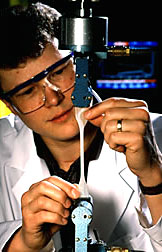Plastic Made More Flexible, More Degradable
|
|
Plastic food packaging materials—even the socalled biodegradable ones—that are dumped into the sea or washed into streams can stay fairly intact for years. Scientists at the National Center for Agricultural Utilization Research (NCAUR) in Peoria, Illinois, are hoping to see that time reduced to months, or even weeks.
“We’re looking for a way to make low-cost, extruded plastic into a "box lunch" for microbes by incorporating amino acids,” says NCAUR chemist Thomas M. Stein.
Amino acids are among the most nutritive sources of the nitrogen which, along with carbon, is essential to microbes that chew up biodegradable plastics. And besides nourishing the microbes, amino acids could serve as plasticizers—components that, especially in high-starch plastic, help prevent brittleness and cracking.
In his research, Stein used a single-screw extruder to melt and blend composites of dried starch and the conventional plasticizers urea, sucrose, and ammonium chloride. Then he compared those blends with ones containing starch and the amino acids glycine, isoleucine, and proline.
Only proline was superior to urea in providing flexibility in concentrations up to 29 percent of the weight of the composites. However, at low relative humidities around 20 percent, the proline composites became glassy instead of flexible—less than ideal for making plastics.
Another drawback to using starch proline composite is its cost. Although starch currently sells for as little as 10 cents per pound, proline costs up to 20 times that amount.
Still, researchers are impressed enough to want to understand why proline works so well and outperforms the amino acid glycine, which they thought should work better. By conducting further experiments and using computer modeling to learn about what makes a good plasticizer, the scientists may synthesize better and cheaper ones than proline from natural materials.
Then, if dry-blended starch and plasticizer ingredients costing less than a dollar per pound can be run through the moist heat and shearing environment of an extruder, perhaps a plastic could be formed that does not need an external nitrogen source for biodegradation. — By Ben Hardin, ARS.







